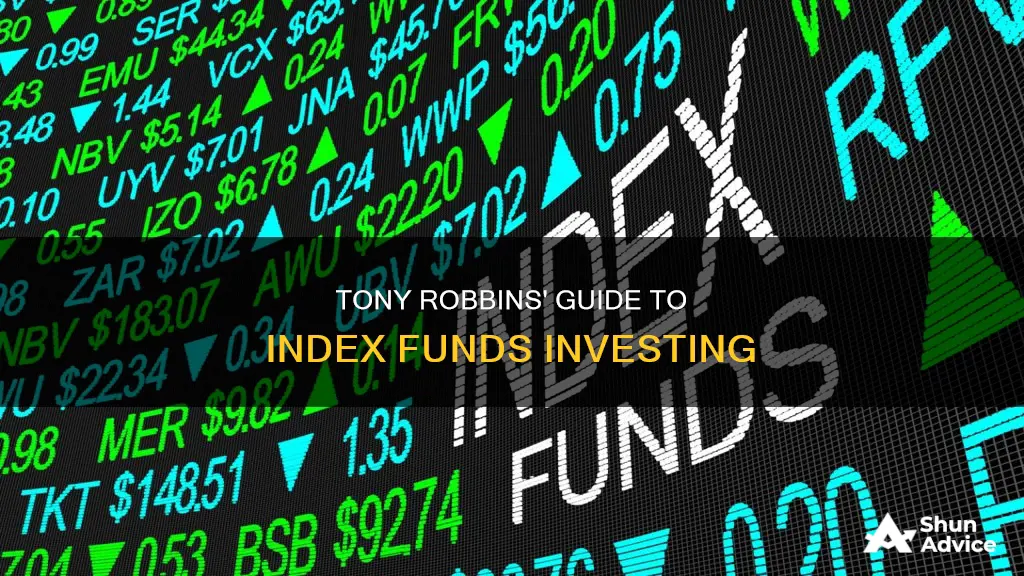
Tony Robbins is a world-renowned life and business strategist, author, entrepreneur, and philanthropist. He has coached over 50 million people and has interviewed 50 of the world's best investors, including Warren Buffett, Jack Bogle, and Ray Dalio. In his book Unshakeable, Robbins emphasizes the importance of investing in index funds, especially for those who are young or new to the market. Index funds are a basket of stocks with hundreds or thousands of different ones inside, offering a simple and cost-effective way to diversify your investments. They follow a passive approach with minimal trading activity, reducing the risk of human error and mistakes made by active fund managers. Robbins also stresses the importance of keeping costs low, automating investments, and taking advantage of compound interest. He recommends diversifying across asset classes, within asset classes, across markets, economies, and time to minimize risk and maximize returns.
| Characteristics | Values |
|---|---|
| Recommended by Tony Robbins | Yes |
| Recommended by Warren Buffett | Yes |
| Recommended for | Young or new investors |
| Type of fund | Basket of stocks with hundreds or thousands of different ones inside |
| Example | S&P 500, a fund that holds stocks for the 500 largest companies in the U.S. |
| Advantage | Cheapest and easiest way to diversify your money |
| Advantage | Ebbs and flows with the market, staying relatively consistent and avoiding the risk associated with picking individual stocks |
| Advantage | Not actively managed by humans, thus avoiding human error |
| Book | Tony Robbins explains index funds in more detail in his book "Unshakeable" |
What You'll Learn

Index funds are a good place to start investing
Index funds are a type of investment fund that holds a basket of different stocks. For example, the S&P 500 is an index fund that holds stocks from the 500 largest companies in the US, including well-known names such as Apple, Google, and Exxon. Because index funds are not actively managed by humans, they avoid the mistakes that active fund managers can make. This passive approach means that index funds ebb and flow with the market, staying relatively consistent and avoiding the high risk associated with individual stocks.
Robbins also emphasizes the importance of diversification in investing. By investing in index funds, investors can achieve diversification by owning a small piece of many different companies across various industries. This helps to minimize risk while still offering the opportunity for financial gain.
In addition, index funds are a cost-effective way to invest. They have low turnover rates, which means their fees and tax bills tend to be low. This makes them an attractive option for those who are young or new to the market, as recommended by both Robbins and Warren Buffett.
Overall, index funds offer a relatively safe and low-cost way to start investing, providing diversification and minimizing risk. By investing in index funds, individuals can begin to build their financial future and take advantage of the power of compounding.
A Beginner's Guide to Index Funds via Wells Fargo
You may want to see also

Diversify your investments
Diversifying your investments is a crucial step in achieving financial success and building a robust investment portfolio. Tony Robbins emphasizes the importance of diversification to minimize risk and maximize returns. Here are some key insights from Robbins on how to diversify your investments effectively:
Understand the Benefits of Diversification
Diversification is a risk management strategy that involves spreading your investments across various assets, industries, and geographies. By allocating your funds to different areas, you reduce the impact of any single investment on your overall portfolio. This strategy helps to minimize risk and stabilize returns. As Tony Robbins puts it, "You can't put all of [your money] in one place."
Diversify Across Asset Classes
Robbins suggests diversifying your investments across different asset classes, such as stocks, bonds, real estate, commodities, and private equity. By allocating your funds to a variety of asset classes, you can balance your portfolio and reduce the impact of fluctuations in any one market.
Diversify Within Asset Classes
Diversification within asset classes is also essential. Avoid putting all your money into a single stock or bond. Spread your investments across a range of companies and industries within each asset class to minimize the impact of individual stock or sector performance on your portfolio.
Global Diversification
Consider diversifying your investments globally by investing in different markets, countries, and currencies. This type of diversification can help you access new opportunities and reduce the impact of country-specific or currency-related risks.
Diversify Across Time
Diversifying across time involves investing at regular intervals and holding investments for different durations. This strategy, known as dollar-cost averaging, helps to smooth out the impact of market volatility and can lead to better long-term returns.
Understand the Core Principles of Diversification
Tony Robbins outlines four core principles of financial success, which include diversification:
- Protect the Principal: Focus on preserving your capital. Structure your portfolio to minimize losses, especially during market downturns.
- Take Asymmetric Risks: Seek to take the least amount of risk for the highest potential upside. Look for opportunities where the potential reward far outweighs the risk involved.
- Tax Efficiency: Consider the tax implications of your investments. Structure your portfolio to minimize taxes and maximize your after-tax returns.
- Diversify, Diversify, Diversify: Diversification is a central theme in Robbins' investment philosophy. It's important to diversify not only across asset classes but also within them, as well as globally and across time.
By following these principles and diversifying your investments, you can build a robust and well-balanced portfolio that can weather market fluctuations and provide opportunities for long-term growth.
Best Mutual Funds: Where to Invest Smartly
You may want to see also

Avoid the risk of picking individual stocks
Index funds are a great way to avoid the risk of picking individual stocks. Tony Robbins recommends index funds as a good starting point for anyone new to investing.
Index funds can be thought of as a "basket of stocks" with hundreds or thousands of different ones inside. For example, the S&P 500 is a fund that holds stocks for the 500 largest companies in the US, including well-known names such as Apple, Google, Exxon, and Johnson & Johnson. By investing in an index fund, you get to own a small piece of all these big companies, thus diversifying your portfolio and reducing risk.
Index funds are also a good choice because they are passively managed, meaning there is no active fund manager making decisions that could be wrong or misguided. As Tony Robbins puts it, "When you own an index fund, you're also protected against all the downright dumb, mildly misguided, or merely unlucky decisions that active fund managers are liable to make."
Additionally, index funds are a cost-effective way to invest. They are known for being low-cost, with minimal trading and management fees. This is in contrast to mutual funds, which often come with high fees that can eat into your investment returns. According to a study by the University of California, the University of Virginia, and Virginia Tech, mutual fund trading costs investors 1.44% per year on average, and up to 3.17% for small-cap funds.
Another benefit of index funds is their tax efficiency. Since they don't constantly trade individual companies, you can hold them for the long run and avoid getting hit by taxes each year. This allows your money to compound without the "tax drag" on your returns.
In summary, index funds offer a simple, low-cost, and relatively safe way to invest your money. They are a great choice for anyone looking to avoid the risk of picking individual stocks and wanting to diversify their portfolio.
Equity Index Funds: A Beginner's Guide to Investing
You may want to see also

Low-cost index funds are a time-proven method
Index funds are a basket of stocks with hundreds or thousands of different ones inside. The S&P 500, for example, is a fund that holds stocks for the 500 largest companies in the U.S., including well-known companies such as Apple, Google, Exxon, and Johnson & Johnson. Nick Holeman, a certified financial planner at Betterment, explains that index funds are "the cheapest and easiest way to diversify your money."
Because index funds ebb and flow with the market, they stay relatively consistent and avoid the risk associated with picking individual stocks. As Tony Robbins writes in his book "Unshakeable," index funds take a "passive approach" that eliminates almost all trading activity. Humans aren't actively managing these funds, so they aren't actively making mistakes either.
Warren Buffett has even said that if anything were to happen to him, he would advise his wife to invest in index funds. He believes in this strategy so much that he made a $1 million bet with hedge fund Protégé Partners that index funds would outperform hedge funds over a decade. Buffett won the bet, and the money was donated to charity.
Tony Robbins also emphasizes the importance of keeping costs low when investing. Active traders incur constant commissions and fees, which can kill investment performance. By investing in index funds through a consistent investment program, investors can take advantage of dollar-cost averaging and keep their costs low.
In addition to low costs, diversification is key to a successful investment strategy. As Tony Robbins says, "You can't put all of [your money] in one place." By investing in index funds, investors can achieve diversification across different asset classes and within asset classes, as well as across markets, economies, and time.
Overall, low-cost index funds offer a time-proven method for investors to make consistent returns while minimizing risk and keeping costs low.
DFA Funds: Smart Investment, Diversified Returns
You may want to see also

Index funds eliminate human error
Index funds are a great way to invest, especially for younger or newer investors. They are a basket of stocks with hundreds or thousands of different ones inside. Nick Holeman, a certified financial planner, explains that they are "the cheapest and easiest way to diversify your money that you're investing".
Index funds are passively managed, meaning they are not actively managed by humans. This eliminates human error, which is common when picking individual stocks. Tony Robbins writes in his book "Unshakeable" that "index funds take a 'passive' approach that eliminates almost all trading activity". He goes on to say that "when you own an index fund, you're also protected against all the downright dumb, mildly misguided or merely unlucky decisions that active fund managers are liable to make".
Index funds are a great way to diversify your portfolio and reduce risk. They are not prone to the same volatility as individual stocks because they ebb and flow with the market, staying relatively consistent. This means that they avoid the high risk associated with picking individual stocks.
Index funds have become extremely popular in the last 20 years, with investors collectively transferring billions of dollars every year from actively managed funds to passively managed funds. This is because they tend to outperform actively managed funds. According to the latest S&P Dow Jones Indices SPIVA research report, 92-95% of actively managed funds failed to beat their passive index benchmarks over a 15-year period.
However, it is important to note that the past performance of index funds may not indicate future performance. Some experts believe that index funds might be setting investors up for a generation of disappointing returns.
Despite this, index funds are still a great option for investors, especially those who are just starting out or who are looking for a more passive approach to investing. They provide diversification, reduce risk, and eliminate human error, making them a popular and effective investment choice.
Mutual Funds in the Philippines: Best Places to Invest
You may want to see also
Frequently asked questions
Investing in index funds is a good way to diversify your investments, especially if you're new to the market. They are a low-cost way to invest in a wide range of stocks, which reduces the risk associated with picking individual stocks.
An index fund is like a basket of stocks with hundreds or thousands of different ones inside. For example, the S&P 500 index fund holds stocks from the 500 largest companies in the US, including Apple, Google, and Microsoft. By investing in an index fund, you're buying a small piece of each of these companies, which diversifies your investment and reduces risk.
Tony Robbins recommends buying low-cost index funds, such as the S&P 500 index fund. This is a passive investment strategy that avoids the high fees and mistakes associated with actively managed funds. You can set up automatic deductions from your paycheck to invest in index funds and take advantage of dollar-cost averaging.







